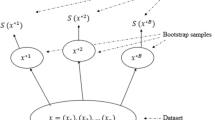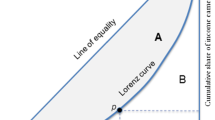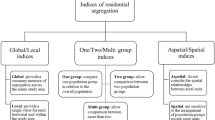Abstract
This paper proposes an alternative measure of economic segregation by income that utilizes the Gini index as the basis of measurement. The Gini Index of Spatial Segregation (GSS) is a ratio of two Gini indices that compares the inequality between neighbourhoods to the inequality between individuals at the macro-level where neighbourhoods are nested. Unlike earlier measures of segregation found in the literature, the GSS uses individualized neighbourhoods, which can be defined as an area constituted within a radius or as a population count method around an individual geo-location, depending on the population density and proximity among individuals in the study area. The GSS can measure residential segregation by any continuous variable for both radii and k-nearest neighbours (knn with and without a decay factor) approaches to bespoke neighbourhoods. Therefore, it is sensitive to the spatial configuration of the area, easy to compute and interpret, and suitable for comparative studies of segregation over time and across different contexts. An empirical application of the index is illustrated using data from Sweden that covers the entire population for 1994, 2004, and 2014. We demonstrate how the definition and scale of the neighbourhood influence the measures of economic segregation. Overall, the GSS offers a flexible and robust framework for measuring segregation that can be used to inform policy decisions and research on inequality.




Similar content being viewed by others
Data availability
The datasets used in this study are register datasets and are subject to copyrights. As a result, they are not publicly available for sharing or distribution.
Notes
Here, we note that the second version of the software “EquiPop flow” can also integrate frictions (water body, etc.) in the road networks and can be used for defining more refined neighbourhoods.
References
Burgers J, Musterd S (2002) Understanding urban inequality: a model based on existing theories and an empirical illustration. Int J Urban Reg Res 26(2):403–413. https://doi.org/10.1111/1468-2427.00387
Clark WA, Östh J (2018) Measuring isolation across space and over time with new tools: evidence from Californian metropolitan regions. Environ Plan B: Urban Anal City Sci 45(6):1038–1054. https://doi.org/10.1177/2399808318756642
Davidoff T (2005) Income sorting: measurement and decomposition. J Urban Econ 58(2):289–303. https://doi.org/10.1016/j.jue.2005.05.003
Dawkins CJ (2004) Measuring the spatial pattern of residential segregation. Urban Studies 41(4):833–851. https://doi.org/10.1080/0042098042000194133
Dawkins CJ (2007) Space and the measurement of income segregation. J Reg Sci 47(2):255–272. https://doi.org/10.1111/j.1467-9787.2007.00508.x
Dorfman R (1979) A formula for the Gini coefficient. Rev Econ Stat. https://doi.org/10.2307/1924845
Epple D, Filimon R, Romer T (1984) Equilibrium among local jurisdictions: toward an integrated treatment of voting and residential choice. J Public Econ 24(3):281–308. https://doi.org/10.1016/0047-2727(84)90012-4
Essletzbichler J (2015) The top 1% in US metropolitan areas. Appl Geogr 61:35–46. https://doi.org/10.1016/j.apgeog.2015.01.019
Getis A (2009) Spatial weights matrices. Geogr Anal 41(4):404–410. https://doi.org/10.1111/j.1538-4632.2009.00768.x
Hardman A, Ioannides YM (2004) Neighbors’ income distribution: economic segregation and mixing in US urban neighborhoods. J Hous Econ 13(4):368–382. https://doi.org/10.1016/j.jhe.2004.09.003
Hong SY, Sadahiro Y (2014) Measuring geographic segregation: a graph-based approach. J Geogr Syst 16:211–231. https://doi.org/10.1007/s10109-013-0190-7
Jahn J, Schmid CF, Schrag C (1947) The measurement of ecological segregation. Am Sociol Rev 12(3):293–303. https://doi.org/10.2307/2086519
Jargowsky PA (1996) Take the money and run: economic segregation in us metropolitan areas. American Sociol Rev. https://doi.org/10.2307/2096304
Kim J, Jargowsky PA (2009) The GINI coefficient and segregation on a continuous variable. Occup Resid Segregation. https://doi.org/10.1108/s1049-2585(2009)0000017006
Lee BA, Reardon SF, Firebaugh G, Farrell CR, Matthews SA, O’Sullivan D (2008) Beyond the census tract: patterns and determinants of racial segregation at multiple geographic scales. Am Soc Rev 73(5):766–791. https://doi.org/10.1177/000312240807300504
Lorenz MO (1905) Methods of measuring the concentration of wealth. Publ Am Stat Assoc 9(70):209–219. https://doi.org/10.1080/15225437.1905.10503443
Massey DS, Denton NA (1988) The dimensions of residential segregation. Soc Forces 67(2):281–315. https://doi.org/10.2307/2579183
Morenoff JD, Tienda M (1997) Underclass neighborhoods in temporal and ecological perspective. Ann American Acad Polit Soc Sci 551(1):59–72
Olteanu M, de Bezenac C, Clark W, Randon-Furling J (2020) Revealing multiscale segregation effects from fine-scale data: a case study of two communities in Paris. Spatial Demogr 8(3):255–267. https://doi.org/10.1007/s40980-020-00065-4
Openshaw S (1983) The modifiable areal unit problem. Geo Books, Norwick, Norfolk. https://doi.org/10.1177/0002716297551001005
Östh J (2014) Introducing the EquiPop software – an application for the calculation of k-nearest neighbour contexts/neighbourhoods. Available from url: http://equipop.kultgeog.uu.se
Östh J, Lindgren U (2012) Do changes in GDP influence commuting distances? A study of Swedish commuting patterns between 1990 and 2006. Tijdschr Econ Soc Geogr 103(4):443–456. https://doi.org/10.1111/j.1467-9663.2011.00697.x
Östh J, Türk U (2020) Integrating infrastructure and accessibility in measures of bespoke neighbourhoods. In: Musterd S (ed) Handbook on Urban segregation. Edward Elgar, pp 378–394. https://doi.org/10.4337/9781788115605.00031
Östh J, Clark WA, Malmberg B (2015) Measuring the scale of segregation using k-nearest neighbor aggregates. Geogr Anal 47(1):34–49. https://doi.org/10.1111/gean.12053
Östh J, Lyhagen J, Reggiani A (2016) A new way of determining distance decay parameters in spatial interaction models with application to job accessibility analysis in Sweden. ENTER 16(2):344–363. https://doi.org/10.18757/ejtir.2016.16.2.3142
Östh J, Shuttleworth I, Niedomysl T (2018) Spatial and temporal patterns of economic segregation in Sweden’s metropolitan areas: a mobility approach. Environ Plan a: Econ Space 50(4):809–825. https://doi.org/10.1177/0308518x18763167
Panzera D, Postiglione P (2020) Measuring the spatial dimension of regional inequality: an approach based on the Gini correlation measure. Soc Indic Res 148(2):379–394. https://doi.org/10.1007/s11205-019-02208-7
Reardon SF, Bischoff K (2011) Income inequality and income segregation. Am J Sociol 116(4):1092–1153. https://doi.org/10.1086/657114
Reardon SF, Firebaugh G (2002) Measures of multigroup segregation. Sociol Methodol 32(1):33–67. https://doi.org/10.1111/1467-9531.00110
Reardon SF, Matthews SA, O’Sullivan D, Lee BA, Firebaugh G, Farrell CR, Bischoff K (2008) The geographic scale of metropolitan racial segregation. Demography 45(3):489–514. https://doi.org/10.1353/dem.0.0019
Reardon SF (2011) Measures of income segregation. Unpublished Working Paper. Stanford Center for Education Policy Analysis. 1(7)
Rey SJ, Smith RJ (2013) A spatial decomposition of the Gini coefficient. Lett Spat Resour Sci 6(2):55–70. https://doi.org/10.1007/s12076-012-0086-z
Rogerson PA, Plane DA (2013) The Hoover index of population concentration and the demographic components of change: an article in memory of Andy Isserman. Int Reg Sci Rev 36(1):97–114. https://doi.org/10.1177/0160017612440811
Sadahiro Y (2015) A method for analyzing the segregation between point distributions: statistical tests and consideration of attributes. J Geogr Syst 17:29–60. https://doi.org/10.1007/s10109-014-0205-z
Schelling TC (1969) Models of segregation. Am Econ Rev 59(2):488–493
Silber J (1989) Factor components, population subgroups and the computation of the Gini index of inequality. Rev Econ Stat. https://doi.org/10.2307/1928057
Tammaru T, Marcińczak S, Van Ham M, Musterd S (2014) Socio-economic segregation in European capital cities. Routledge, Abingdon. https://doi.org/10.2139/ssrn.2713024
Tammaru T, Sinitsyna A, Akhavizadegan A, Ham M V, Marcińczak S, Musterd S (2021) Income Inequality and Residential Segregation in European Cities. In Urban Inequality and Segregation in Europe and China. Springer, Cham. https://doi.org/10.1007/978-3-030-74544-8_3
Tiebout CM (1956) A pure theory of local expenditures. J Polit Econ 64(5):416–424. https://doi.org/10.1086/257839
Türk U, Östh J (2019) How much does geography contribute? Measuring inequality of opportunities using a bespoke neighbourhood approach. J Geogr Syst 21:295–318. https://doi.org/10.1007/s10109-019-00297-z
van Ham M, Tammaru T, Janssen HJ (2018) A multi-level model of vicious circles of socio-economic segregation. Divided cities: understanding intra-urban disparities. OECD, Paris https://doi.org/10.1787/9789264300385-en
White MJ (1983) The measurement of spatial segregation. American J Sociol. https://doi.org/10.1086/227768
Wong DW (1993) Spatial indices of segregation. Urban Studies 30(3):559–572. https://doi.org/10.1080/00420989320080551
Wong DW (1999) Geostatistics as measures of spatial segregation. Urban Geogr 20(7):635–647. https://doi.org/10.2747/0272-3638.20.7.635
Wong DW (2005) Formulating a general spatial segregation measure. Prof Geogr 57(2):285–294. https://doi.org/10.1111/j.0033-0124.2005.00478.x
Wong DW, Shaw SL (2011) Measuring segregation: an activity space approach. J Geogr Syst 13:127–145. https://doi.org/10.1007/s10109-010-0112-x
Wong DW (2004) The modifiable areal unit problem (MAUP) World minds: geographical perspectives on 100 problems, 571–575. https://doi.org/10.1007/978-1-4020-2352-1_93
Wyly EK, Glickman NJ, Lahr ML (1998) A top 10 list of things to know about American cities. Cityscape. https://doi.org/10.2139/ssrn.156910
Yang R, Jargowsky PA (2006) Suburban development and economic segregation in the 1990s. J Urban Aff 28(3):253–273. https://doi.org/10.1111/j.1467-9906.2006.00291.x
Funding
No funds, grants, or other support was received.
Author information
Authors and Affiliations
Corresponding author
Ethics declarations
Conflict of interest
The authors have no relevant financial or non-financial interests to disclose.
Additional information
Publisher's Note
Springer Nature remains neutral with regard to jurisdictional claims in published maps and institutional affiliations.
Electronic supplementary material
Below is the link to the electronic supplementary material.
Appendix
Rights and permissions
Springer Nature or its licensor (e.g. a society or other partner) holds exclusive rights to this article under a publishing agreement with the author(s) or other rightsholder(s); author self-archiving of the accepted manuscript version of this article is solely governed by the terms of such publishing agreement and applicable law.
About this article
Cite this article
Türk, U., Östh, J. Introducing a spatially explicit Gini measure for spatial segregation. J Geogr Syst 25, 469–488 (2023). https://doi.org/10.1007/s10109-023-00412-1
Received:
Accepted:
Published:
Issue Date:
DOI: https://doi.org/10.1007/s10109-023-00412-1






